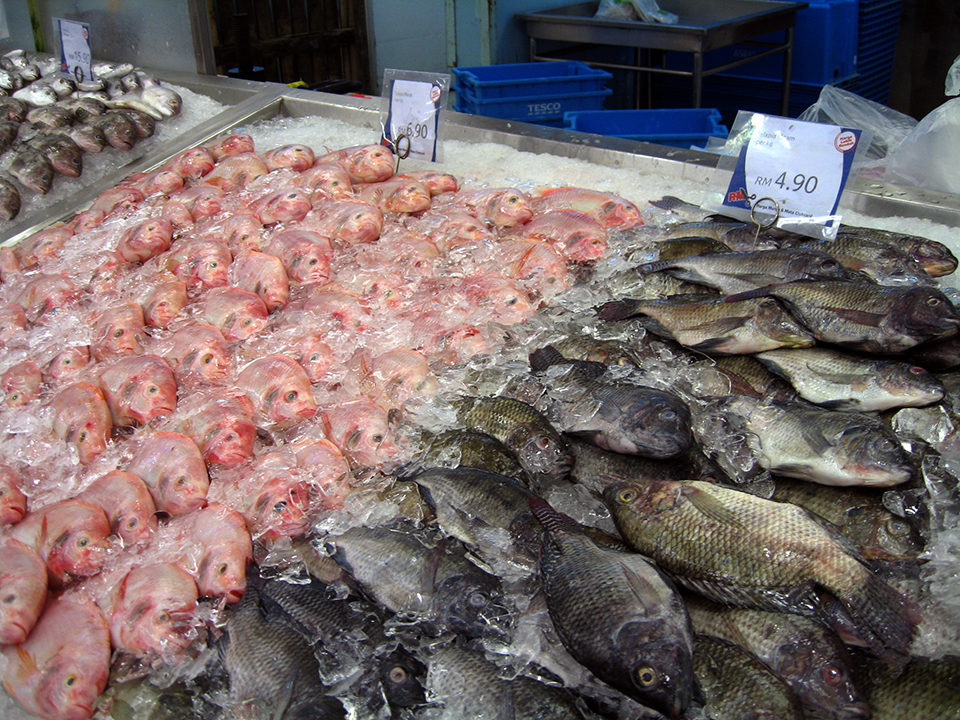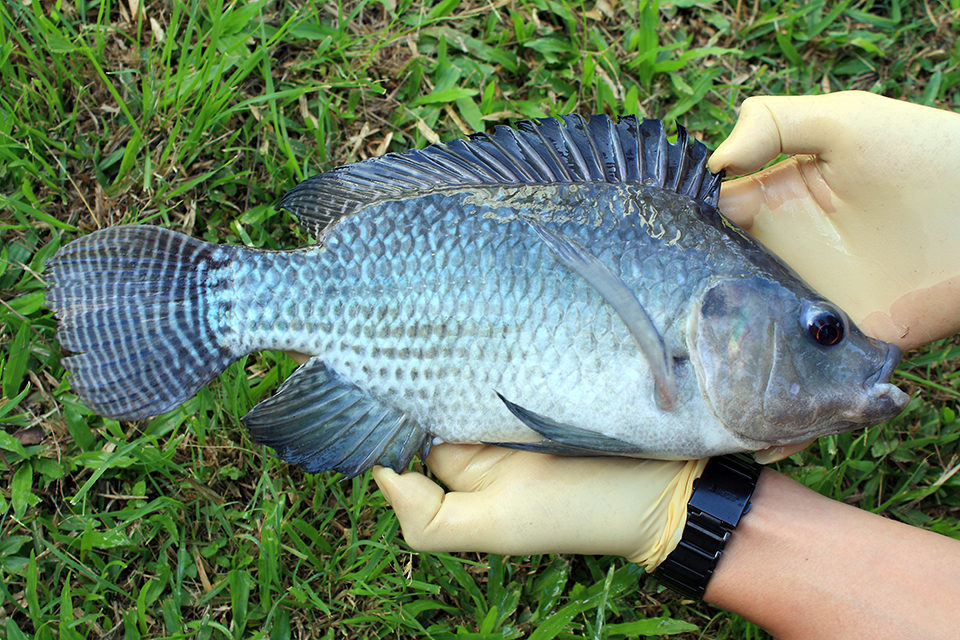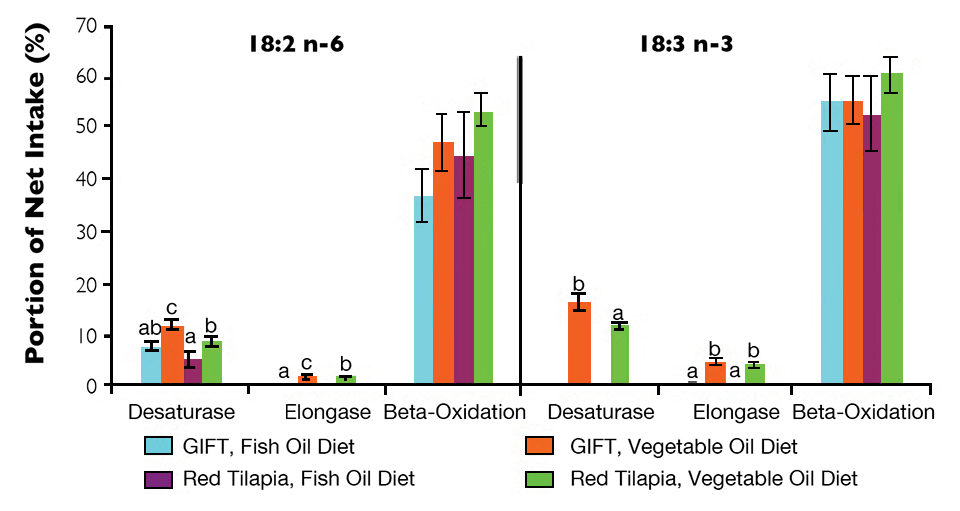Farming improved tilapia strains a more economically viable and environmentally friendly option

Traditionally, fish oil has been the major dietary lipid source used in commercial fish feeds, including tilapia feeds. As global fish oil production is stagnating, increasing demand has inflated prices and necessitated the use of alternative lipid resources in aquafeeds. Vegetable oils are viable alternatives, as they are readily available and their production is sustainable and more cost-effective than for fish oil.
Several studies have reported that vegetable oil can partially or fully replace fish oil in fish diets without compromising growth performance in a variety of species as long as their essential fatty acid requirements are met. However, vegetable oils do not contain the omega-3 long-chain polyunsatured fatty acids (LC-PUFAs) known to be beneficial to human health.
Since it is generally known that dietary fatty acid composition is reflected in the farmed fish fillets, the modification of the fatty acid profiles of fillets from fish fed vegetable oil sources is likely the most stringent constraint of fish oil replacement in aquafeed. It is therefore not surprising that there is great interest in understanding the capabilities of farmed fish in bioconverting the two basic 18:2 and 18:3 omega-3 essential fatty acids commonly present in vegetable oils into the longer-chain and more unsaturated fatty acids of the omega-6 and omega-3 classes, respectively.
Feeding trial
The authors previously showed that the genetically improved farmed tilapia (GIFT) strain of Nile tilapia was more efficient in utilizing dietary protein compared to red hybrid tilapia. Lipid digestibility was also slightly higher for the GIFT tilapia.
Recently, the authors conducted a study to determine if the improved growth performance of the GIFT strain is also related to differences in the overall efficiency of their fatty acid metabolism, and whether tilapia genotypes play a role in the ability of the fish to utilize dietary fatty acids. The authors were also interested in estimating the fishes’ capability to produce long-chain polyunsaturated fatty acids (LC-PUFAs) from dietary linoleic acid (18:2 omega-6) and alpha-linolenic acid (18:3 omega-3).
The authors conducted a feeding trial using the GIFT strain of Nile tilapia developed by the WorldFish Center and red hybrid tilapia. The fish received semipurified diets based on fish oil or blended vegetable oil for 14 weeks.
The vegetable oil-based feed was formulated using 15 percent olive oil, 15 percent sunflower oil, 30 percent linseed oil and 40 percent refined, bleached, deodorized palm olein, which was added at a level of 10 percent of the total diet. The fatty acid composition of the diet was formulated to mimic the major fatty acid classes of the fish oil diet.
LC-PUFAs were completely absent in the vegetable oil diet. Eicosapentae-noic acid (EPA, 20:5 omega-3) and docosahexanoic acid (DHA, 22:6 omega-3) were the main omega-3 PUFAs in the fish oil diet, while the omega-3 PUFA content of the vegetable oil diet was solely provided by 18:3 omega-3.
Results
Results showed that the blended vegetable oil could totally replace fish oil as the dietary lipid source for tilapia without negatively impacting (P > 0.05) growth performance. GIFT tilapia fed the fish oil or vegetable oil diets contained 9.41 and 9.61 grams lipid/100 grams, respectively. This was significantly higher than the lipid content observed in red hybrid tilapia fed the same diets.
Tilapia fed the diet with vegetable oil and no PUFAs longer than C18 accumulated significant amounts of omega-6 and omega-3 LC-PUFAs. Specifically, total omega-3 LC-PUFA content was over 24 mg/gram of lipid – about double the amount found in the initial fish.
The DHA content in the tilapia fed the vegetable oil diet (GIFT, 113 mg/100 grams; red hybrid tilapia, 85 mg/100 grams) was approximately a third of that in fish fed the fish oil diet (GIFT, 321 mg/100 grams; red hybrid tilapia, 335 mg/100 grams). However, arachidonic acid (ARA, 20:4 omega-6) content was slightly higher in tilapia fed the vegetable oil-based diet.
At harvest, GIFT and red hybrid tilapia fed the diet with blended vegetable oil contained 127 mg and 96 mg EPA+ DHA/100 grams, respectively which still represented significant amounts of these beneficial omega-3 fatty acids for human consumers. Within the broader context of the perceived impacts of aquaculture on global omega-3 LC-PUFA supply and availability, the present results indicated that tilapia farming can be a net producer of omega-3 fatty acids. This bodes well for the farming of tilapia, which is already often seen as an environmentally friendly farmed species.

Fatty acid metabolism
Irrespective of dietary treatment and genotype, all fish showed an active ex novo production (liponeogenesis) of saturated and monounsaturated fatty acids. In fish fed the vegetable oil diet, the fatty acid neogenesis recorded in GIFT tilapia was three-fold higher than in red hybrid tilapia, while the beta-oxidation of saturated and monounsaturated fatty acids was 1.7-fold lower.
Therefore, it seems GIFT tilapia may require higher tissue contents of saturates and monoenes than red hybrid tilapia and are achieving this by increasing fatty acid neogenesis and, at the same time, partially reducing the oxidation of these needed fatty acids. Providing improved strains of farmed tilapia with higher dietary levels of saturated and monounsaturated fatty acids may result in improved growth performance and feed utilization.
Bioconversion
The diet with blended vegetable oil led to higher apparent in vivo fatty acid beta-oxidation compared to the fish oil diet, irrespective of genotype. This was basically due to the significantly higher oxidation of 18:3 omega-3 and 18:2 omega-6, which were abundantly supplied with the diet and oxidized to supply dietary energy. However, some of the dietary 18:3 omega-3 and 18:2 omega-6 was bioconverted into more physiologically important LC-PUFAs.
The tilapia showed quite efficient 18:3 omega-3 bioconversion up to the production of DHA. Tilapia fed the vegetable oil diet recorded efficient delta-6 and delta-5 desaturation and elongation of both omega-3 and omega-6 PUFAs. GIFT tilapia exhibited the more abundant fatty acid bioconversion activities of both fatty acid classes (Fig. 1).

In tilapia fed the vegetable oil diet, the bioconversion of 18:2 omega-6 to longer and more unsaturated fatty acid was quite efficient, resulting in similar final content of arachidonic acid in tilapia fed the fish oil diet, which provided a dietary source of this fatty acid. The GIFT tilapia fed the vegetable oil diet had higher contents of ARA, EPA and DHA than red hybrid tilapia.
Dietary lipid source significantly contributed to higher apparent in vivo delta-6 desaturase and elongase activity on 18:2 omega-6 and 18:3 omega-3, with fish fed the vegetable oil diet having significantly higher activities (Fig. 1). Delta-6 desaturase activity on 18:2 omega-6 and 18:3 omega-3 was significantly higher in GIFT tilapia compared to red hybrid tilapia. In fish fed the fish oil diet, the dietary supply of 18:3 omega-3 was minimal, and thus the majority of delta-6 desaturation acted on 18:2 omega-6.
Perspectives
Overall, total fatty acid beta-oxidation and delta-5 and delta-6 desaturation were higher in fish fed the diet with vegetable oil compared to values for fish on the fish oil diet. Independently from the diet, GIFT tilapia showed significantly better and more efficient fatty acid neogenesis and bioconversion activities compared to red hybrid tilapia.
This observation, coupled with the ever-increasing need for replacing fish oil in aquafeed formulations, further reinforces the zootechnical advantages of culturing these improved Nile tilapia strains. Therefore, the farming of improved tilapia strains is not only a more economically viable option, but also a more environmentally friendly one, as the cultivation of these tilapia strains may rely less heavily on marine-derived raw materials for aquafeed production.
Editor’s Note: This article was based on a paper published in the journal Aquaculture (2011).
(Editor’s Note: This article was originally published in the March/April 2011 print edition of the Global Aquaculture Advocate.)
Authors
-
Wing-Keong Ng, Ph.D.
Fish Nutrition Laboratory
School of Biological Sciences
Universiti Sains Malaysia
Penang 11800, Malaysia -
Chaiw-Yee Teoh
Fish Nutrition Laboratory
School of Biological Sciences
Universiti Sains Malaysia -
Giovanni M. Turchini, Ph.D.
School of Life and Environmental Sciences
Deakin University
Warrnambool, Victoria, Australia
Tagged With
Related Posts

Aquafeeds
A look at phospholipids in aquafeeds
Phospholipids are the major constituents of cell membranes and are vital to the normal function of every cell and organ. The inclusion of phospholipids in aquafeeds ensures increased growth, better survival and stress resistance, and prevention of skeletal deformities of larval and juvenile stages of fish and shellfish species.

Health & Welfare
A look at tilapia aquaculture in Ghana
Aquaculture in Ghana has overcome its historic fits and starts and is helping to narrow the gap between domestic seafood production and consumption. Production is based on Nile tilapia.

Intelligence
Adding value to tilapia to tap into U.S. market
New markets for tilapia and expansion of existing ones can be created by planning and implementing properly designed geographic strategies to meet discriminating consumer preferences. Low labor costs in most producing countries promotes value-adding by the production of fresh fillets.

Intelligence
What will it take to make tilapia great again?
Once a darling of the sustainable seafood crowd for its vegetarian diet and potential to feed the world’s growing population, mild-mannered tilapia now has an image problem that may be causing a dip in consumption levels.


